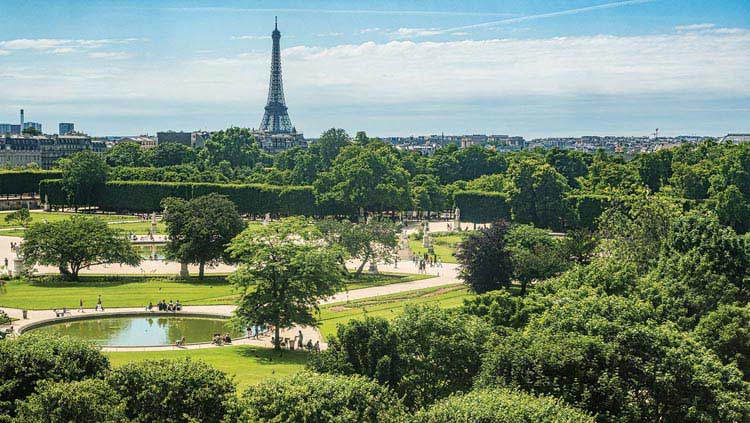
Weekly News Review August 5 – August 11 2024
August 12, 2024
Dysprosium Price Forecast: A Cornerstone for the Green Economy
August 15, 2024Welcome to the Olympics 2024, hosted in Paris for the first time since 1924, exactly 100 years ago. How very different our technologies are today and how very different our concerns for the present and future of our green and blue planet are.
The raw materials we offer as physical assets are the backbone of the energy transition to a more sustainable future. Today we look at our role and how Paris is leading the way forward.
Islands of freshness for a city that is constantly heating up –
Climate change has already significantly affected life in major European cities for several years and will be even more impacted in the future, for example, by more extended periods of heat in summer. The French capital, Paris, has been particularly hit hard: it could experience a climate like Seville in southern Spain, with temperature peaks of up to 50 degrees.
Predestined for Heat Waves –
First, there are some unique factors to consider in Paris: it has a high level of surface sealing and is dark due to its asphalt and zinc roofs, which absorb light and heat and transmit them to the environment. In the 1960s and 1970s, house facades were often built with single glazing and no insulation. Most buildings were also constructed primarily to protect from cold, but not from heat. This type of construction means that heat builds up very strongly in the French metropolis.
From Oven City to Oasis City –
The deputy mayor, Christophe Najdovski, also responsible for public and green spaces in Paris, said that heavily overbuilt cities such as Paris could even turn into authentic ovens in extreme heat due to global warming. He continues that trees are essential for cooling cities down, as the temperature in the shade of trees is four degrees lower. To protect itself from excessive heat, especially in the increasingly hot summers, Paris, the second largest city in Europe, put together a significant package of measures in June ladt year to better combat the heatwaves expected in the city.
The steps are combined in the concept entitled “Paris adapts” (originally: Paris s’adapte). The French capital has taken Seville and Tunis as an example—both cities have long experienced hot summers and have had to take appropriate action to combat them.
Reflecting White Roofs, Planted Areas, Cooling With Water – The Possibilities Are Diverse –
Paris wants to replace 100 hectares of asphalt with green areas in the coming years. To achieve this goal, three more forests will be created in Paris. A total of 170,000 new trees are to be planted in the new forests and parks. In only six months, between November 2022 and April 2023, for example, Paris already planted 25,000 trees.
Over 900 parks and squares in Paris also act as “islands of freshness” for the population; more than a quarter of the city’s surface area, including forests, is covered with vegetation. Where trees cannot be planted, the city creates shade roofs in pavilions or green pergolas, for example, in public squares and parks.
Another of the city’s measures is to create more green spaces in the streets, for example, through more vertical planting on buildings. Currently, 136 hectares of building walls have already been covered with plants; this is set to increase to 150 hectares by 2026.

Refreshment for the Parisian Population –
In addition to increased urban greening, the Paris administration also provides opportunities to cool down during hot weather. Numerous drinking fountains and water diffusers—some new, others to be installed in many places—provide refreshment. There are 1,200 of these water points throughout the city.
Another simple measure that provides cooling is painting the roofs of houses white or applying white coatings. This lowers the temperature under the roof by two to three degrees, thus protecting buildings from overheating. The deputy mayor of Paris, Dan Lert, who is also in charge of the energy transition, announced: “Several roofs on public buildings that are a priority for the City of Paris will also be painted white. When the light is reflected, the ground heats up less.” Paris invests 100 million euros every year in the ecological transformation of buildings.
Paris Climate Protection Plan: More Solar Panels for “The City of Light” –
The city has developed a climate protection plan in 2023, the “Plan Climat de Paris“. Unlike the “Paris adapts” concept, this plan does not contain short-term measures but rather longer-term actions on how the French capital can combat further global warming. These include its intention to use only renewable energies in the city by 2050. One-fifth of this energy is generated by a 5,000 to 10,000 square meter solar power plant in the “Parc Floral du Bois de Vincennes.” The city has also set itself the goal of installing solar panels on 20 percent of Parisian roofs.
More Electromobility, Fewer Emissions –
Making public transport fossil fuel-free by 2025 is another goal of the climate protection plan, as transport is the primary source of carbon emissions in the French metropolis. Therefore, Paris focuses on pedestrians, cyclists, and public transport by offering better options and faster connections to encourage more people not to use cars. The aim is not only to improve services but also to switch to electric public transport ashore and to run the vehicles used for water transportation with green energy by 2030.
At the same time, the city wants to ban diesel cars from the urban landscape by 2024 and petrol cars by 2030. To promote the expansion of electromobility, the city is subsidizing the purchase of electric bikes or cars, hybrids, or even hydrogen cars.
It remains to be seen whether these quick solutions will also achieve the desired long-term results. However, Paris may have to initiate many more measures in the coming years to react to climate-related circumstances in the city, which can only be predicted to a limited extent at present.





